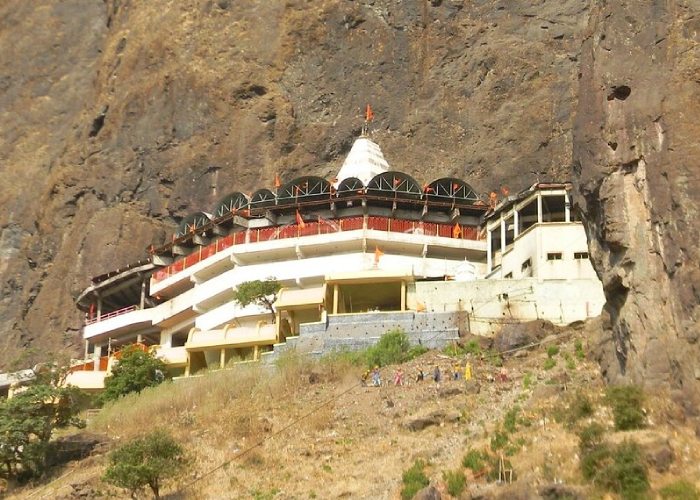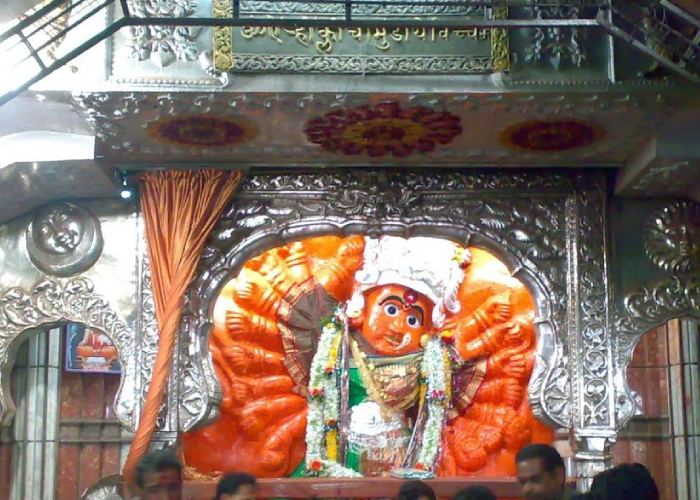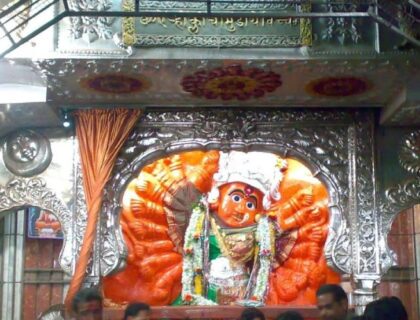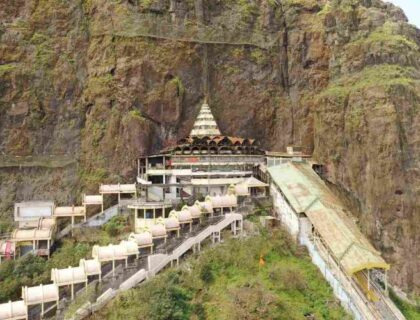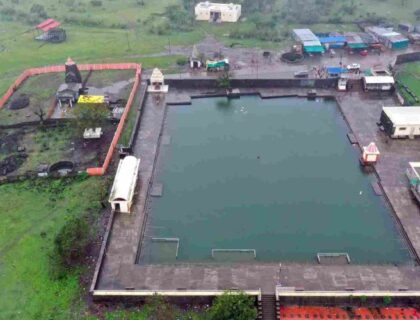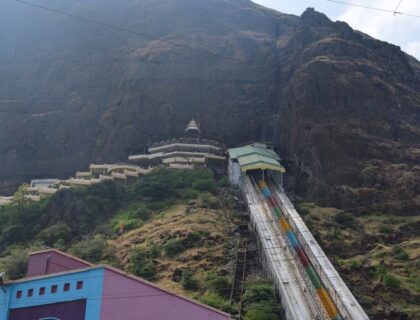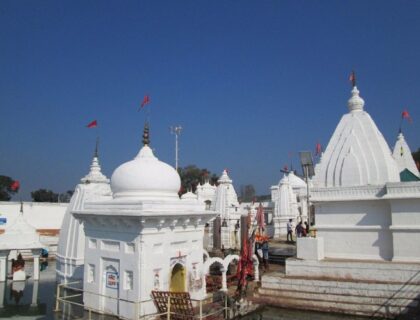Saptashrungi Bhramari Shaktipeeth
Saptashrungi Bhramari Shaktipeeth or Saptshringi Temple is a site of Hindu pilgrimage situated 60 kilometres from Nashik in the Indian state of Maharashtra. According to Hindu legends, each of the seven mountain peaks is home to the goddess Saptashrungi. Shrung refers to peaks, and sapta refers to seven. It is in the Indian village of Nanduri, Kalwan taluka, close to Nashik. The goddess is venerated by the Marathas and some Hindu tribes for a very long time, and some consider it to be their kuldaivat.
Saptashrungi Bhramari Shaktipeeth is one of the 51 Shaktipeeth. The goddess of this temple is also called the goddess of seven hills. Every day devotees come from all over India for the darshan of Mother Saptashrungi Devi. The Devi is said to be swayambhu (self-manifested) on a rock on the sheer face of a mountain. She is surrounded by seven (sapta-in Sanskrit) peaks (shrunga-in Sanskrit), hence the name- Sapta Shrungi Mata (mother of the seven peaks).
Story Behind Saptashrungi Bhramari Shaktipeeth
The goddess of Dakshayani, Sati, Parvati, or Durga Hinduism’s most important woman and most powerful deity is called Shakti. Durga Devi, Mahakali, and Gowri are the three main manifestations of Shakti, the power goddess. She is Adi Shakti’s avatar.
Sati was the Prajapati Daksha’s daughter, and she married Lord Shiva despite Her father’s wishes. Prajapati Daksha once put together a massive yagya, but he didn’t call his daughter and son-in-law. Sati was very saddened by Her father’s actions. When she got there, her father ignored the Sati and insulted her. She could not bear the insult of his husband (Lord Shiva) and she jumped into the fire of Yagya and committed suicide. She passed away, but her body didn’t burn. Lord Shiva had taken His Virabhadra Rupa out of rage. Daksha’s head was cut off by him, but in the end, He forgave him by bringing him back to life.
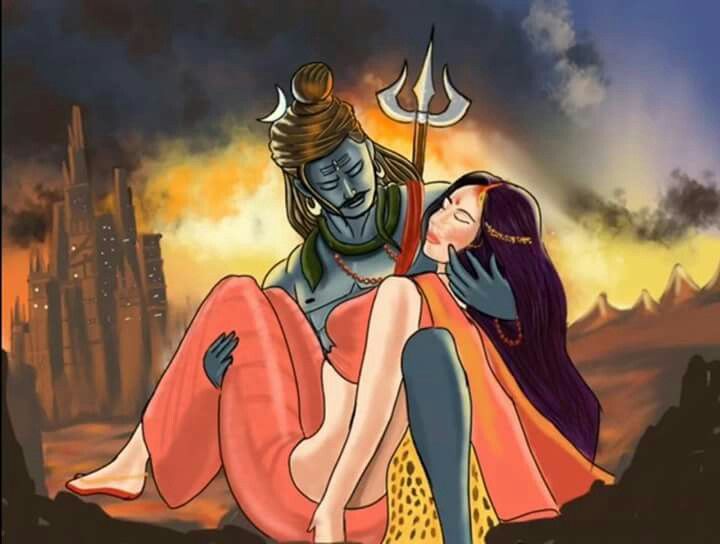
Lord Shiva, devastated, had taken Sati’s body and wandered the universe. Finally, Lord Vishnu used His Chakra to break the Sati’s body into pieces. Each body part transformed into Shakti Pitha. The temple had emerged where the body part had fallen to the ground. In order to safeguard the Shakti Pitha, Lord Shiva created 51 Bhairava for each one.
The temple is famous in Maharashtra as the ‘Three and half Shakti Peeth’. According to Hindu traditions, the goddess Saptashringi resident is located within seven mountain peaks. Sapta means seven and shrung means peak. The Goddess’s location is surrounded by the seven hills of Saptashringi, a mountain. which is commonly known as Ghads. Peaks average approximately 4500 feet in height on average.

Saptashrungi Bhramari Shaktipeeth is One of the 51 Shaktipeeth Temples. The goddess of this temple is called the goddess of seven slopes. In the Godavari river valley in Nasik city fell both parts of the chin of Goddess Sati. Saptashrungi Bhramari Shaktipeeth is also known as chibuka.
History of Saptashrungi Bhramari Shaktipeeth
Saptashrungi Devi is said to be Mahishasur Mardini, the buffalo-shaped demon who was killed by Saptashrungi. It is believed that the sage Markandeya wrote the Devi Mahatmya, a sacred book that praises Devi’s greatness and her accomplishments. Markandeya performed arduous penance on a hill opposite the one where Devi lives, which is now named after him.
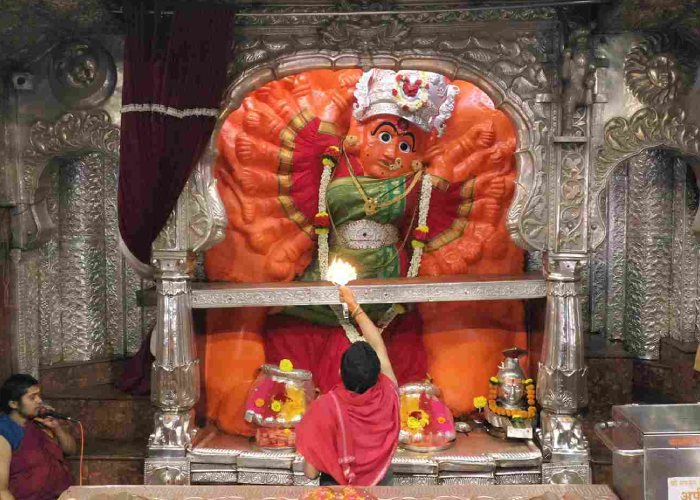
These eighteen hands of Devi are described by Akhyaika in the Devi Mahatmya. It is accepted that a savage evil presence named Mahishasura began to inconvenience everybody. By doing penance to Lord Brahma, Mahishasura got a boon of immortality. However, only a woman could cause Mahishasura’s demise. All the deities invoked Adishakti to kill Mahisharoor.
Furthermore, the goddess battled with Mahishasura and killed him. Additionally, this took place on seven hills within the Saptshrungi Mata mandir. Vani devi (Saptashrungi Mata) is also known as Mahishasur Mardhini because of this. Devi was given 18 weapons from all the gods to kill Mahishasura. Additionally, she has 18 hands full of those 18 weapons.
The architecture of Saptashrungi Bhramari Shaktipeeth
The Devi is said to be swayambhu (self-manifested) on a rock on the sheer face of a mountain. She is surrounded by seven (sapta-in Sanskrit) peaks (shrunga-in Sanskrit), hence the name- Sapta Shrungi Mata (mother of the seven peaks).

The design of the Saptashrungi Bhramari Shaktipeeth resembles that of the portico structure temples of the last centuries and is attributed to Satara Commander N Chief. The Vani Saptashrungi devi is decorated daily with a nose ring (Natni), crowns on her head, gold necklaces, and a colourful saree. Since the idol of Saptashrungi devi is 8 feet tall, she needs a 10.05-meter saree (11 varsadi) and 3-meter cloth for choli.

The Devi is a massive figure that stands about 10 feet tall and has 18 hands holding various weapons. Sindoor, which is regarded as beneficial in this region, is always applied to the idol’s exterior. It holds weapons like Strings of Beads Battle Axe, Mace Arrow, Thunderbolt Lotus, Bow Water Pot, Cudgel Lance, Sword Shield, Conch Bell, Wine Cup Trident and Noose Spinning Disc which is known as the Sudarsana Chakra.
Facts about Saptashrungi Bhramari Shaktipeeth
- Saptashrungi Bhramari Shaktipeeth is a Hindu temple situated near Nanduri village in Nashik. The temple lies atop the cliff with an altitude of 1,230 m.
- The temple is dedicated to Goddess Saptashrungi. The temple is known popularly as one of the ‘three and a half Shakti Peethas’ of Maharashtra.
- The temple is also one among the 51 Shakti Peethas located on the Indian subcontinent and is a location where one of Sati’s limbs, her right arm is reported to have fallen
- The image of the Devi is huge-about 10 feet tall with 18 hands, holding various weapons.
- The idol is always coated with Sindoor, which is considered auspicious in this region.
- It is one of the most important of the places of Goddesses in Maharashtra. There is an old path with steps cut out of the mountain, which starts right at the foothills. However, now, a motorable road has been built, which goes up to an altitude of 1150 meters.
- There are several other shrines close to the Saptashrungi temple. Some of these shrines include Jalagumpha, Kalikund and Suryakund, Shivtirtha, Markendeya Darshan, Tambultirtha and SatichaKada.
- She is also known as Brahmasvarupini (“one who has the form of Brahma”). The goddess is reported to have appeared from the kamandalu (water pot) of the creator-god Brahma.
Festivals In Saptashrungi Bhramari Shaktipeeth
- Durga Puja. (Winter) – Devotees celebrate Navaratri at this temple in the month of Ashwin (Sep-Oct).
- Navaratri. (Summer) – They celebrate other Navaratri in the fortnight of the Chaitra (March-April). At each nine days, they worship Navadurga (nine Durgas).
- Diwali – Diwali is one of the most admired and auspicious festivals in the town.
- Gudhipadwa: Gudi Padwa is the festival that augments the new year and is usually celebrated on the first day of the Indian month of Chaitra according to the Hindu lunar calendar.
- Chaitrotsav: The festival starts on Rama Navami (the ninth lunar day in the bright fortnight of the Hindu month of Chaitra) and culminates on Chaitra Poornima (full moon day), the biggest day of the festival.
- Mahashivratri– Mahashivaratri is the day when the Shiva Tattva touches the earth. Shivaratri is like a new year for a saadhak (seeker).
How to Reach Saptashrungi Bhramari Shaktipeeth
Nashik is one of the major cities, districts, and pilgrimage centres in Maharashtra, India, and is thus well connected by road, rail, and air networks to all major cities in India.
By Air: Ojhar Nashik International Airport is located just 24 km away from the city.
By Railway: The distance between Nashik Road Railway Station to Saptashrungi Bhramari Shaktipeeth is 4 Km by road while Nashik Railway Station is at a distance of nearly 78.8 kilometres from the Holy Temple.
By Road: There are regular bus services available for the temple. The buses run from the Nashik CBS bus stop. Reach Nashik and take a Taxi or Bus from Nashik City to Vani. You can go by your private vehicle to the top of Nanduri gad Nashik.
Also Read – Jwala Devi Shaktipeeth
Support Us
If our content helps you even 1% in gaining information about the temple, please support us by contributing any amount, our UPI ID is - q417999792@ybl Or pay using QR CODE >>> Click Now
Location
Facilities
- Drinking Water
- Pooja Item Shops
- Prasad Shops
- Restaurants Nearby
- Resting Room

